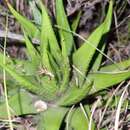fr
noms dans le fil d’Ariane


Haworthia kingiana ist eine Pflanzenart der Gattung Haworthia in der Unterfamilie der Affodillgewächse (Asphodeloideae). Das Artepitheton kingiana ehrt Haworthia-Sammlerin Frau E. B. King.[1]
Haworthia kingiana wächst stammlos und sprosst langsam. Die verschmälerten, ausgebreiteten, lanzettlich-dreieckigen Laubblätter bilden eine Rosette mit einer Höhe von bis zu 18 Zentimetern. Die gelblich grüne Blattspreite ist bis zu 16 Zentimeter lang und 1,8 Zentimeter breit. Sie ist so dick wie breit. Die Blattoberfläche ist rau. Auf ihr befinden sich erhabene gerundete Warzen, die nicht zusammenfließen.
Der lockere Blütenstand ist spärlich verzweigt und besteht aus 30 bis 40 Blüten. Die Blütenröhre ist verkehrt kopfig. Die Zipfel der Perigonblätter sind kurz und rosarötlich geadert.
Haworthia kingiana ist in der südafrikanischen Provinz Westkap verbreitet.
Die Erstbeschreibung durch Karl von Poellnitz wurde 1935 veröffentlicht.[2] Nomenklatorisches Synonym sind Haworthia subfasciata var. kingiana (Poelln.) Poelln. (1938) und Haworthia pumila var. kingiana (Poelln.) Halda (1997).
Haworthia kingiana ist eine Pflanzenart der Gattung Haworthia in der Unterfamilie der Affodillgewächse (Asphodeloideae). Das Artepitheton kingiana ehrt Haworthia-Sammlerin Frau E. B. King.
Tulista kingiana is a species of succulent plant, from the Western Cape, South Africa. It is listed as Endangered on the IUCN global Red List
It was formerly classed in the genus Haworthia, as Haworthia kingiana.[3]
It is an evergreen succulent plant with rosettes of short, sharp, bright green, succulent leaves. The leaves are usually covered with flat, shiny tubercles. These are usually rounded and white, but they are occasionally elongated or slightly translucent. The plant gradually produces offsets and can form clumps. In November and December it produces pink-white flowers.
The bright, yellow-green colour is the distinguishing feature of Tulista kingiana. In other ways though, this species is quite variable. Even in one locality there can be great variety in leaf shape, growth form and tubercles.
It was formerly classed in the genus Haworthia, with the other large species (T.pumila, T.minima & T.marginata) in the "Robustipedunculares" subgenus. Following recent phylogenetic studies, it has been shown that these four species in fact constitute a distinct out-group, separate from other Haworthias. They have therefore been classed as a separate genus, "Tulista".[4]
The natural distribution of this species is a small area centred on Mossel Bay, in the far south of the Cape, South Africa. Its population is very sparse in this area, and its natural range extends from as far east as Great Brak, to Herbertsdale in the West and north of the Langeberg mountains into the Little Karoo where it is extremely rare. Its habitat is usually renosterveld and grassland patches on top of rocky, exposed hills and slopes. In the wild its natural threats are seasonal fires and grazing by wildlife.[5]
Currently the plant is listed as an Endangered species because of human pressures and it has become very rare. It is severely threatened by illegal collecting for the horticultural trade and by habitat destruction.[6]
Tulista kingiana is very highly prized as an ornamental and it is grown for horticultural reasons. It is long-lived and slow-growing. It is difficult in cultivation and it needs very well-drained soil and good air movement. The plant slowly offsets so propagation can be by off-sets, by leaf-cuttings or by seed.
Tulista kingiana is a species of succulent plant, from the Western Cape, South Africa. It is listed as Endangered on the IUCN global Red List
It was formerly classed in the genus Haworthia, as Haworthia kingiana.
Haworthia kingiana là một loài thực vật có hoa trong họ Măng tây. Loài này được Poelln. mô tả khoa học đầu tiên năm 1937.[1]
Haworthia kingiana là một loài thực vật có hoa trong họ Măng tây. Loài này được Poelln. mô tả khoa học đầu tiên năm 1937.